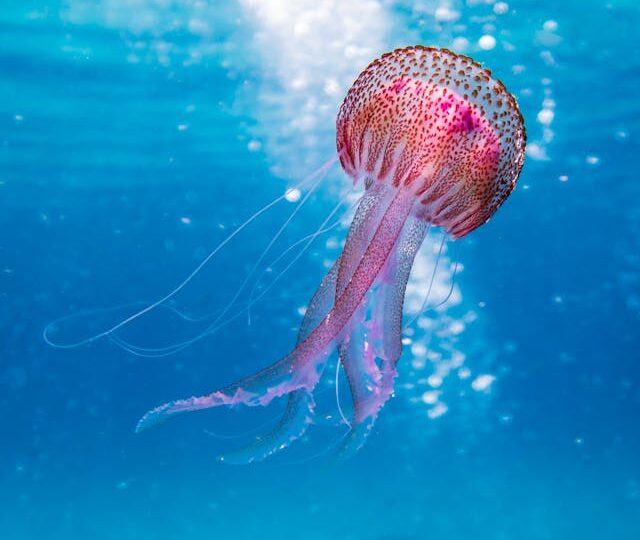Welcome back to GertieBlu, where we dive deep into the wonders of the ocean and its many mysteries! Today, we’re going to explore one of the most captivating and otherworldly creatures to float through the sea—jellyfish. If you’ve ever seen a jellyfish in an aquarium or washed up on the shore, you know just how strange and mesmerizing they appear. But what makes them look so bizarre? And, more importantly, should we be worried about them? Let’s get into it!
What Makes Jellyfish Look So Unique?
Jellyfish are undoubtedly one of the most alien-looking creatures on Earth, but their peculiar design is more than just for show. Every feature serves a purpose!
1. Body Composition:
Jellyfish are made up of 95% water! This is why they seem almost transparent and gelatinous. The body of a jellyfish is very simple compared to other sea creatures—no brain, heart, or bones. Instead, they consist of a bell-shaped body (the “medusa”) and tentacles hanging below, which help them catch prey. Their jelly-like structure allows them to float effortlessly through water, making them perfectly adapted for life in the ocean’s currents.
2. Mesmerizing Glow:
Have you ever noticed that some jellyfish glow in the dark? This phenomenon, known as bioluminescence, is common among deep-sea species. The glow can help them attract prey or warn predators to stay away. Other jellyfish use light in even more fascinating ways—some can create a flash of light when disturbed, as if they were saying, “Back off!”
3. Oddly Simple Nervous System:
Despite their lack of a brain, jellyfish have a basic nervous system that helps them respond to their environment. Their nerve net allows them to detect light, gravity, and nearby movements, which helps them navigate through the water and catch prey with their tentacles. It’s like a simple autopilot system that ensures they survive, even in challenging ocean conditions.

Are Jellyfish Dangerous?
Now, onto the big question: should we be worried about these strange and floaty creatures?
1. Stingers on Standby:
Jellyfish have tentacles lined with tiny stinging cells called nematocysts. When something brushes against these tentacles, the nematocysts fire, injecting venom into their target. This venom is used to paralyze and capture prey, such as small fish and plankton.
But what about humans? While most jellyfish stings are not life-threatening, they can be quite painful. The severity of a sting depends on the species. For instance:
- Mild Stingers: Many species of jellyfish found in shallow coastal waters will give you a painful sting, but the symptoms usually subside after a few hours or days. These include species like the moon jellyfish.
- Dangerous Stingers: Some jellyfish, like the infamous box jellyfish, are much more dangerous. Found primarily in the waters of Australia and Southeast Asia, their sting can be deadly if not treated quickly. The venom of a box jellyfish can cause heart failure, making it one of the most dangerous marine creatures in the world.
2. What to Do If You Get Stung:
If you ever find yourself on the receiving end of a jellyfish sting, here’s what to do:
- Rinse with seawater: Freshwater can trigger more venom release, so stick to seawater.
- Vinegar rinse: For some jellyfish, vinegar can help neutralize the venom.
- Remove tentacles: Use tweezers or a credit card to gently scrape off any remaining tentacles.
- Pain relief: Applying heat (like a hot pack) can help ease the pain.
And, of course, if you suspect a severe reaction (difficulty breathing, chest pain, or feeling faint), seek medical attention immediately!

Beauty in the Unique
Despite their potential danger, jellyfish are essential to ocean ecosystems and offer a beauty that can’t be ignored. Their delicate, flowing movements and bioluminescent glow remind us of how diverse and fascinating marine life can be. Whether you’re admiring them from behind the glass of an aquarium or spotting them from the shore, jellyfish capture our imagination with their ethereal presence.
So, are jellyfish unique? Absolutely. Are they dangerous? Sometimes. But one thing is for sure—these gelatinous creatures continue to fascinate us and remind us of the incredible variety of life beneath the waves.
Until next time, stay curious, and keep exploring the wonders of the deep blue on GertieBlu!









